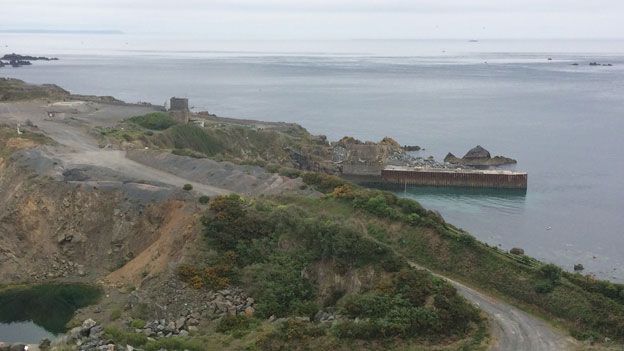Cornwall marine life worry over Swansea lagoon quarrying
- Published

Plans to extract rock to build a £1bn tidal lagoon in Swansea Bay have caused controversy - because of their potential impact on a marine conservation area in Cornwall.
A decision is expected soon on whether the UK government supports the tidal energy project.
But there has been opposition to planned jetties and a breakwater wall needed to ship rock to south Wales.
The lagoon developer said no decisions had been taken about rock supply.
With fewer working quarries in Cornwall, 40 to 50 jobs could be created if Dean Quarry near St Keverne reopens.
Its stone helped build the Channel Tunnel but it closed in 2008 after 100 years.
Local objections to it starting up again began two years ago, when the Manacles Marine Conservation Zone (MCZ) became one of 28 new protected sites around England and Wales.
Species include sea-fan anemone and wildlife include the spiny lobster and stalked jellyfish.
Farmers and tourist businesses on the eastern side of Cornwall's Lizard peninsula in particular have been concerned at the proposal to transport the hard Gabbro rock on barges to Swansea.
Around the lagoon's wall - which would be almost six miles long - a layer of rock would act as armour for the new breakwater wall.
The new owner of the quarry will be Shire Oak Quarries Ltd, subject to planning approval.
An artist's impression of how the lagoon around Swansea Bay could look if given the go-ahead
This is a subsidiary of Shire Oak Energy, whose chief executive Mark Shorrock is also head of Tidal Lagoon Power (TLP).
Shire Oak is expected to apply to Cornwall County Council for planning permission next month.
It involves replacing an old 30m jetty with two 100m-long jetties, protected by a 535m-long breakwater to keep the Atlantic swell and bad weather from disrupting any loading.
Mr Shorrock did not want to discuss the quarry until the planning application had been submitted, but acknowledged the pivotal step was getting the UK government's go-ahead for the lagoon.
"We have to get planning, without planning we don't have a project - so 10 June is everything for us," he said.
"We will start by making piles and piles of rock in the sea - we'll get sand from the middle of [Swansea] bay and build two piles of rock and start building up and build out from near the docks."
A statement from TLP said it would soon appoint a marine works contractor to build the lagoon wall and "it will be the responsibility of the contractor to source and transport rock to the project".
It added: "No decisions have been taken with regards rock supply. Sustainability is designed into the core of the lagoon and we are no less demanding of our supply chain."
WORRIES OVER THE IMPACT
Mike Anselmi, who runs a diving business, is worried about the impact
Mike Anselmi, who runs Porthkerris Divers, says it would have an impact on his family business as well as the sea and marine life.
He believes the quarry will present the first challenge to the conservation zone since it was set up in 2013.
Roskilly's organic dairy farm is 700m away from the quarry and Toby and Silke Roskilly graze cattle on land next door.
They employ 60 people during the summer months as the farm produces ice cream and has a cafe, shop and visitor attractions.
"My family have been farming here since 1950," said Toby Roskilly.
"It's been a working quarry for most of my life but we're no longer talking about a small quarry but something absolutely huge.
"We lived with a sheen of dust in the fields in the past but we think there's going to be vast increase in that and traffic on the roads."
Natural England and the Maritime Management Organisation (MMO) are also likely to have views on the application.
TPL is also waiting for news about its marine licence from Natural Resources Wales.
So the next two months are crucial for the project, as are TLP's continuing negotiations with the UK government on the subsidy paid for the power it will generate for decades to come.
If TLP gets the asked for strike price of £168 per megawatt hour (MWH) of energy, there are plans for a fleet of much larger lagoons in the Severn Estuary.
If all these hurdles are overcome, the hope is to start work by March 2016.
- Published18 March 2015
- Published2 March 2015
- Published2 December 2014
- Published7 February 2014